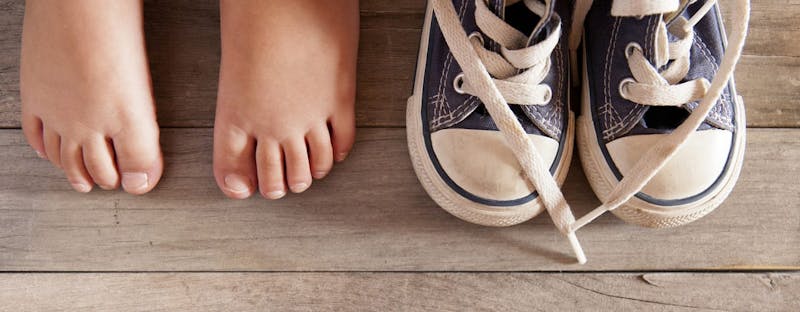Schedule a Consultation
Contact Us


Approximately 98 percent of children are actually born with healthy feet, but only about 40 percent of kids will be still be enjoying healthy feet as adults. A significant contributing factor is the shoes worn throughout the different stages of life. Since children’s feet are constantly growing and developing, it’s especially critical to choose the right shoe when it’s time to upgrade to something new. Consider these tips as you make your decision.
Look for the Right Fit
According to some estimates, about half of all children three and under wear shoes that aren’t a proper fit. Part of the reason for this may be the fact that feet can grow rapidly and increase up to 12 sizes during these years. Children over 3 years of age increase their foot size about a half of a size every 4-6 months. Avoid the temptation to pass shoes along from one child to the next. Each child has unique foot features.
Shoes for toddlers should have enough support in the sole to provide sufficient stabilization while learning to walk and improve coordination, although heels are not necessary at this age. Shoes that are too tight can result in bunions, corns, and conditions such as hammertoe and crossover toe. A proper fitting child’s shoe is one with:
Consider Breathability
Breathability should also be considered, since children have feet that sweat more than adult-size feet. Infants have delicate feet, so soft shoes or even slipper socks with anti-slip protection on the bottom should provide sufficient ventilation. Opt for breathable materials like leather and canvas and avoid plastic.
Pay Attention to Shoe Construction/Design
Look for an absorbent material for the insole of your child’s shoe. The outer sole needs to provide sufficient traction. Support in the ankles is especially important for toddlers since they’re often on their feet all day as they learn to get around on their own. Proper ankle support can also minimize a child’s risk of having problems with the development of bones in this area.
When older children start wearing shoes with heel height, it shouldn’t be more than an inch. Durability should be a priority when kids get into sports. Choose shoes appropriate for your child’s sport. Shoes for baseball will be different than ones worn for competitive running or track and field. As a general rule, you want shoes for your child that are well-ventilated and comfortable with some room for growth.
Be mindful of how well your child is getting around in their shoes. If you notice signs of foot pain, take a good look at their shoes to see if it’s time for a new pair. If their shoes aren’t the problem, see your podiatrist to determine if special footwear or orthotics may benefit your child to correct foot irregularities that may affect younger shoe wearers.